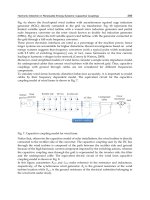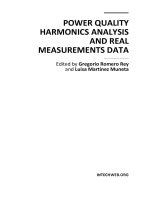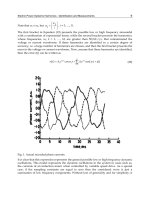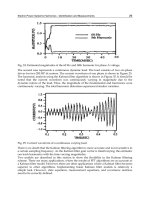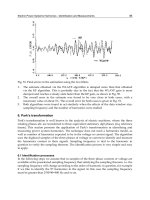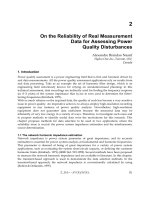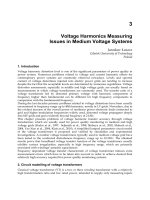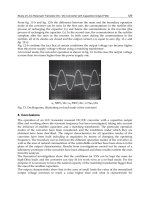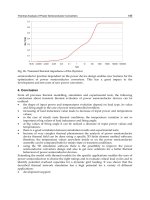Power Quality Monitoring Analysis and Enhancement Part 5 pot
Bạn đang xem bản rút gọn của tài liệu. Xem và tải ngay bản đầy đủ của tài liệu tại đây (2.34 MB, 25 trang )
Application of Signal Processing in Power Quality Monitoring
87
sampling frequency used in (Lu et al., 2005) is 5 kHz and the noisy condition, where signal
to noise ratio value is about 26 dB, is considered.
5. Classification techniques
5.1 Feed Forward Neural Networks (FFNN)
Neural networks are composed of simple elements operating in parallel. These elements are
inspired by biological nervous systems. As in nature, the connections between elements
largely determine the network function. Neural networks can be trained to perform a
particular function by adjusting the values of the connections (weights and biases) between
elements. Generally, neural networks are adjusted, or trained, so that a particular input
leads desired target output. The network is adjusted, based on a comparison of the output
and the target, until the network output matches the target. Usually, many such
input/target pairs are needed to train a network. Neural networks have been trained to
perform complex functions in various fields, including pattern recognition, identification,
classification, speech, vision, and control systems.
Neural networks can also be trained to solve problems that are difficult for conventional
computers or human beings. Neural networks are usually applied for one of the three
following goals:
•
Training a neural network to fit a function
•
Training a neural network to recognize patterns
•
Training a neural network to cluster data
The training process requires a set of examples of proper network behavior i.e. network
inputs and target outputs. During training the weights and biases of the network are
iteratively adjusted to minimize the network performance function (Moravej et al., 2002).
5.2 Radial Basis Function Network (RBFN)
The RBFN model (Mao et al., 2000) consists of three layers: the inputs and hidden and
output layers. The input space can either be normalized or an actual representation can be
used. This is then fed to the associative cells of the hidden layer, which acts as a transfer
function. The hidden layer consists of radial basis function like a sigmoidal function used in
MLP network. The output layer is a linear layer. The RBF is similar to Gaussian density
function, which is de.ned by the “center” position and “width” parameter. The RBF gives
the maximum output when the input to the neuron is at the center and the output decreases
away from the center. The width parameter determines the rate of decrease of the function
as the input pattern distance increases from the center position. Each hidden neuron
receives as net input the distance between its weight vector and the input vector. The output
of the RBF layer is given as
T2
kkkk
Oexp([XC][XC]/2)=−− − σ (20)
where
K1,2, ,N= , where N is the number of hidden nodes
k
O = output of the
K
th node of the hidden layer
X
= input pattern vector
k
C = center of the RBF of K th node of the hidden layer
k
σ = spread of the K th RBF
Power Quality – Monitoring, Analysis and Enhancement
88
Each neuron in the hidden layer outputs a value depending on its weight from the center of
the RBF. The RBFN uses a Gaussian transfer function in the hidden layer and linear function
in the output layer. The output of the
j
th node of the linear layer is given by
T
jjj
YWO= (21)
where
j
1,2, ,M= , where M is the number of output nodes
j
Y = output of the
j
th node
j
W = weight vector for node
j
j
O = output vector from the
j
th hidden layer (can be augmented with bias vector)
Choosing the spread of the RBF depends on the pattern to be classified. The learning process
undertaken by a RBF network may be visualized as follows. The linear weights associated
with the output units of the network tend to evolve on a different “time scale” compared to
the nonlinear activation functions of the hidden units. Thus, as the hidden layer’s activation
functions evolve slowly in accordance with some nonlinear optimization strategy, the
output layer’s weights adjust themselves rapidly through a linear optimization strategy. The
important point to note is that the different layers of an RBF network perform different
tasks, and so it is reasonable to separate the optimization of the hidden and output layers of
the network by using different techniques, and perhaps operating on different time scales.
There are different learning strategies that can be followed in the design of an RBF network,
depending on how the centers of the radial basis functions of the network are specified.
Essentially following three approaches are in use:
•
Fixed centers selected at random
•
Self-organized selection of centers
•
Supervised selection of centers
5.3 Probabilistic neural network (PNN)
The PNN was first proposed in (Spetch 1990; Mao et al., 2000). The development of
PNN relies on the Parzen window concept of multivariate probability estimates.
The PNN combines the Baye’s strategy for decision-making with a non-parametric estimator
for obtaining the Probability Density Function (PDF) (Spetch 1990; Mao et al., 2000). The
PNN architecture includes four layers; input, pattern, summation, and output layers. The
input nodes are the set of measurements. The second layer consists of the Gaussian
functions formed using the given set of data points as centers. The third layer performs an
average operation of the outputs from the second layer for each class. The fourth layer
performs a vote, selecting the largest value. The associated class label is then determined
(Spetch 1990). The input layer unit does not perform any computation and simply
distributes the input to the neurons. The most important advantages of PNN classifier are as
below:
•
Training process is very fast
•
An inherent parallel structure
•
It converges to an optimal classifier as the size of the representative training set
increases
•
There are not local minima issues
•
Training patterns can be added or removed without extensive retraining
Application of Signal Processing in Power Quality Monitoring
89
5.4 Support vector machines (SVMs)
The SVM finds an optimal separating hyperplane by maximizing the margin between the
separating hyperplane and the data (Cortes et al., 1995; Vapnik 1998; Steinwart 2008,
Moravej et al., 2009). Suppose a set of data
m
iii1
T{x,
y
}
=
= where
n
i
xR∈ denotes the feature
vectors,
i
y
{1,1}∈+ −
stands for two classes, and m is the sample number, if two classes are
linearly separable, the hyperplane
f(x) 0=
can be determined such that separates the given
feature vectors.
m
kk
k1
f(x) w.x b w .x b 0
=
=+= +=
(22)
where w and b denote the weight vector and the bias term, respectively. The position of
the separating hyperplane is defined by setting these parameters. Thus the separating
hyperplane satisfy the following constraints:
ii i i
y
f(x )
y
(w.x b) 1, i 1,2, ,m=+≥= (23)
i
ξ
are positive slack variables that measure the distance between the margin and the
vectors
i
x that lie on the incorrect side of the margin. Then, in order to obtain the optimal
hyperplane, the following optimization problem must be solved:
m
2
i
i1
ii i
i
1
Minimize w C , i 1,2, ,m
2
y(w.x b) 1
subject to
0
=
+ξ =
+≥−ξ
ξ≥
(24)
where C is the error penalty.
By introducing the Lagrangian multipliers
i
α , the above-mentioned optimization problem is
transformed into the dual quadratic optimization problem, as follows:
mm
ii
j
i
j
i
j
i1 i,j1
1
Maximize L( )
yy
(x .x )
2
==
α= α− αα
(25)
m
ii i
i1
Sub
j
ect to
y
0, 0, i 1,2, ,m
=
α=α≥ =
(26)
Thus, the linear decision function is created by solving the dual optimization problem,
which is defined as:
m
ii i j
ij 1
f(x) si
g
n
y
(x ,x ) b
=
=α +
(27)
If the linear classification is not possible, the nonlinear mapping function
φ
can be used to
map the original data x into a high dimensional feature space that the linear classification is
possible. Then, the nonlinear decision function is:
m
ii i j
ij 1
f(x) si
g
n
y
K(x ,x ) b
=
=α +
(28)
Power Quality – Monitoring, Analysis and Enhancement
90
where
i
j
K(x ,x ) is called the kernel function,
i
j
i
j
K(x,x) (x) (x)=
φφ
. Linear, polynomial,
Gaussian radial basis function and sigmoid are the most commonly used kernel functions
(Cortes et al., 1995; Vapnik 1998; Steinwart 2008). To classify more than two classes, two
simple approaches could be applied. The first approach uses a class by class comparison
technique with several machines and combines the outputs using some decision rule. The
second approach for solving the multiple class detection problem using SVMs is to compare
one class against all others, therefore, the number of machines is the same number of classes.
These two methods have been described in details in (Steinwart 2008).
5.5 Relevance Vector Machines
Michael E. Tipping proposed Relevance Vector Machine (RVM) in 2001 (Tipping 2000). It
assumes knowledge of probability in the areas of Bayes' theorem and Gaussian distributions
including marginal and conditional Gaussian distributions (Fletcher 2010). RVMs are
established upon a Bayesian formulation of a linear model with an appropriate prior that
cause a sparse representation. Consequently, they can generalize well and provide
inferences at low computational cost (Tzikas 2006; Tipping 2000). The main formulation of
RVMs is presented in (Tipping 2000).
New combination of WT and RVMs are suggested in (Moravej et al., 2011a) for automatic
classification of power quality events. The Authors in (Moravej et al., 2011a) employed the
WT techniques to extract the feature from details and approximation waves. The
constructed feature vectors as input of RVM classifier are applied for training the machines
to monitoring the power quality events. The feature extracted from various power quality
signals are as follow:
1. Standard deviation of level 2 of detail.
2. Minimum value of absolute of level n of approximation. ( n is desirable
decomposition levels)
3. Mean of average of absolute of all level of details.
4. Mean of disturbances energy.
5. Energy of level 3 of detail.
6. RMS value of main signal.
Sag, swell, interruption, harmonics, swell with harmonics, sag with harmonics, transient,
and flicker, was studied. Data is generated by parametric equation an MATLAB
environment. The procedure of classification is tested in noisy conditions and the results
show the efficiency of the method. The CVC method for classification of nine power quality
events is proposed. First time that RVM based classifier for recognition of power quality
events is applied in (Moravej et al., 2011a).
5.6 Logistic Model Tree and Decision Tree
Logistic Model Tree (LMT) is a machine for supervised learning issues. The LMT combines
linear logistic regression and tree induction. The LogitBoost algorithm for building the
structure of logistic regression functions at the nodes of a tree is used. Also, the renowned
Classification and Regression Tree (ACRT) algorithm for pruning are employed. The
LogitBoost is employed to pick the foremost relevant attributes in the data when performing
logistic regression by performing a simple regression in each iteration and stopping before
convergence to the maximum likelihood solution. The LMT does not require any tuning of
parameters by the user (Landwehr 2005; Moravej et al., 2011b).
Application of Signal Processing in Power Quality Monitoring
91
A LMT includes standard Decision Tree (DT) (Kohavi & Quinlan 1999) structure with
logistic regression functions at the leaves. Compared to ordinary DTs, a test on one of the
attributes is related to every inner node.
The new combination as pattern recognition system has been proposed in (Moravej et al.,
2011b). The Authors used LMT based classifier for identification of nine power quality
disturbances. Sag, swell, interruption, harmonics, transient, and flicker, was studied.
Simultaneously disturbances consisting of sag and harmonics, as well as swell and
harmonics, are also considered. Data is generated by parametric equation an MATLAB
environment. The sampling frequency is 3.2 kHz. The feature vector composed of four
features extracted by ST method. In (Moravej et al., 2011b), the features are based on the
Standard Deviation (SD) and energy of the transformed signal and are extracted as
follows:
Feature 1: SD of the dataset comprising the elements corresponding to the maximum
magnitude of each column of the S-matrix.
Feature 2: Energy of the dataset comprising of the elements corresponding to the maximum
magnitude of each column of the S-matrix.
Feature 3: SD of the dataset values corresponding to the maximum value of each row of the
S-matrix.
Feature 4: Energy of the dataset values corresponding to the maximum value of each row of
the S-matrix.
For classification of power quality disturbances, 100 cases of each class are generated for the
training phase, and another 100 cases are generated for the testing phase (Moravej et al.,
2011b). The Sensitivity of the algorithm, in (Moravej et al., 2011b), is also investigated under
noisy condition.
6. Pattern recognition techniques
The functionality of an automated pattern recognition system can be divided into two basic
tasks, as shown in Fig. 1: the description task generates attributes of PQ disturbances using
feature extraction techniques, and the classification task assigns a group label to the PQ
disturbance based on those attributes with a classifier. The description and classification
tasks work together to determine the most accurate label for each unlabeled object analyzed
by the pattern recognition system (Moravej et al., 2010; Moravej et al., 2011a).
Feature extraction is a critical stage because it reduces the dimension of input data to be
handled by the classifier. The features which truly discriminate among groups will assist in
identification, while the lack of such features can prevent the classification task from
arriving at an accurate identification. The final result of the description task is a set of
features, commonly called a feature vector, which constitutes a representation of the data.
The classification task uses a classifier to map a feature vector to a group. Such a mapping
can be specified by hand or, more commonly, a training phase is used to induce the
mapping from a collection of feature vectors known to be the representative of the various
groups among which discrimination is being performed (i.e., the training set). Once
formulated, the mapping can be used to assign identification to each unlabeled feature
vector subsequently presented to the classifier. So, it is obvious that a good feature
extraction technique should be able to derive significant feature vectors in an automated
way along with determining less number of relevant features to characterize the complete
systems. Thus, the subsequent computational burden of the classifier can be reduced.
Power Quality – Monitoring, Analysis and Enhancement
92
Fig. 1. General pattern recognition algorithm for PQ events classification
7. Feature selection
By removing the most irrelevant and redundant features from the data, feature selection
helps to improve the performance of learning models by alleviating the effect of the curse of
dimensionality, enhancing generalization capability, speeding up learning process and
improving model interpretability. If the size of initial feature set is large, exhaustive search
may not be feasible due to processing time considerations. In that case, a suboptimal
selection algorithm is preferred. However, none of these algorithms guarantee that the best
feature set is obtained. The selection methods provide useful information about superiority
of selected features, superiority of feature selection strategy and the relation between the
useful features and the desired feature size (Gunal et al., 2009). Generally the feature
selection methods give answer to some question arises from PQ classification problem as
follows.
7.1 Filter
Filter type methods are based on data processing or data filtering methods. Features are
selected based on the intrinsic characteristics, which determine their relevance or
discriminate powers with regard to the targeted classes. Some of these methods are
described as follows (Proceedings of the Workshop on Feature Selection for Data Mining).
Application of Signal Processing in Power Quality Monitoring
93
7.1.1 Correlation
A correlation function is the correlation between random variables at two different points in
space or time, usually as a function of the spatial or temporal distance between the points. If
one considers the correlation function between random variables representing the same
quantity measured at two different points then this is often referred to as an autocorrelation
function being made up of autocorrelations. Correlation functions of different random
variables are sometimes called cross correlation functions to emphasize that different
variables are being considered and because they are made up of cross correlations.
Correlation functions are a useful indicator of dependencies as a function of distance in time
or space, and they can be used to assess the distance required between sample points for the
values to be effectively uncorrelated. In addition, they can form the basis of rules for
interpolating values at points for which there are observations.
The most familiar measure of dependence between two quantities is the Pearson product-
moment correlation coefficient, or "Pearson's correlation." It is obtained by dividing the
covariance of the two variables by the product of their standard deviations. The population
correlation coefficient ρX,Y between two random variables X and Y with expected values μ
X
and μ
Y
and standard deviations σ
X
and σ
Y
is defined as (Rodgers & Nicewander 1988;
Dowdy & Wearden 1983):
XY
X,Y
XY XY
cov(X,Y) E[(X )(Y )]
corr(X,Y)
−
μ
−
μ
ρ= = =
σσ σσ
(29)
where
E
is the expected value operator, cov means covariance, and, corr a widely used
alternative notation for Pearson's correlation.
The Pearson correlation is +1 in the case of a perfect positive (increasing) linear relationship
(correlation), −1 in the case of a perfect decreasing (negative) linear relationship
(anticorrelation), and some value between −1 and 1 in all other cases, indicating the degree
of linear dependence between the variables. As it approaches zero there is less of a
relationship (closer to uncorrelated). The closer the coefficient is to either −1 or 1, the
stronger the correlation between the variables. Some feature can be selected from feature
space based on the obtained correlation coefficient of potential features.
7.1.2 Product-Moment Correlation Coefficient (PMCC)
For each signal, a set of features may be extracted that characterize the signal. The purpose
of the feature selection is to reduce the dimension of feature vector while maintaining
admissible classification accuracy. In order to, select the most meaningful features Product-
Moment Correlation Coefficient (PMCC or Pearson correlation) method has been applied to
feature vector obtained in feature extraction step.
The Pearson correlation between two variables
X and Y , giving a value between +1 and -1.
A correlation of +1 means that there is a perfect positive linear relationship between
variables. A correlation of -1 means that there is a perfect negative linear relationship
between variables. A correlation of 0 means there is no linear relationship between the two
variables.
Pearson’s correlation coefficient between two variables is computed as (Son & Baek 2008):
n
ii
i1
XY
(X X)(Y Y)
r
(n 1)S S
=
−−
=
−
(30)
Power Quality – Monitoring, Analysis and Enhancement
94
where
r : correlation coefficient
X,Y
: the means of
X
and
Y
respectively
XY
S,S: the standard deviation of X and Y respectively.
The correlation coefficient r is selected as 0.95, 0.9, and 0.85 respectively. The extracted
features, those have correlation more than r will be removed automatically. The dimension
reduction of the feature vector has several advantages including: low computational burden
for training and testing phases of machine learning, high speed of training phase, and
minimization of misclassifications.
Afterwards, feature normalization is applied to ensure that each feature in a feature vector is
properly scaled. Therefore, the different features are equally weighted as an input of
classifiers.
7.1.3 Minimum Redundancy Maximum Relevance (MRMR)
The MRMR method that considers the linear independency of the feature vectors as well as
their relevance to the output variable so it can remove redundant information and collinear
candidate inputs in addition to the irrelevant candidates. This technique is done in two
steps. At first if the mutual information between a candidate variable and output feature is
greater than a pre specified value then it is kept for further processing else it is discarded.
This is the first step of the feature selection technique (‘‘Maximum Relevance’’ part of the
MRMR principle). In the next step, the cross-correlation is performed on the retained
features obtained from the first step. If the correlation coefficient between two selected
features is smaller than a pre specified value both features are retained; else, only the
features with largest mutual information are retained. The cross-correlation process is the
second step of the feature selection technique (‘‘Minimum Redundancy’’ part of the MRMR
principle) (Peng et al., 2005). So, the proposed feature selection technique is composed of a
mutual information based filter to remove irrelevant candidate inputs and a correlation
based filter to remove collinear and redundant candidates. Two thresholds values must be
determined for two applied filters in the first and second steps. Retained variables after the
two steps of the feature selection are selected as the input of the forecast engine. In order to
obtain an efficient classification scheme, threshold values (adjustable parameters) must be
fine tuned.
7.2 Wrapper
Wrapper based methods use a search algorithm to seek through the space of possible
features and evaluate each subset by running a model on the selected subset. Wrappers
usually need huge computational process and have a risk of over fitting to the model.
7.2.1 Sequential forward selection
Sequential forward selection was first proposed in (Whitney 1971). It operates in the bottom-
to-top manner. The selection procedure begins with a null subset initially. Then, at each
step, the feature that maximizes the criterion function is added to the current subset. This
procedure continues until the requested number of features is selected. The nesting effect is
present such that a feature added into the set in a step can not be removed in the subsequent
steps (Gunal et al., 2009). As a consequence, SFS method can yield only the suboptimal result.
Application of Signal Processing in Power Quality Monitoring
95
7.2.2 Sequential backward selection
Sequential backward selection method proposed in works in a top-to-bottom manner (Marill
& Green 1963). It is the reverse case of SFS method. Initially, complete feature set is
considered. At each step, a single feature is removed from the current set so that the
criterion function is maximized for the remaining features within the set. The removal
operation continues until the desired number of features is obtained. Once a feature is
eliminated from the set, it can not enter into the set in the subsequent steps (Gunal et al.,
2009).
7.2.3 Genetic algorithm
Genetic algorithms belong to the larger class of Evolutionary Algorithms (EA), which
generate solutions to optimization problems using techniques inspired by natural evolution,
such as mutation, selection, and crossover. The evolution usually starts from a population of
randomly generated individuals and happens in generations. In each generation, the fitness
of every individual in the population is evaluated, multiple individuals are stochastically
selected from the current population based on their fitness, and modified (recombined and
possibly randomly mutated) to form a new population. The new population is then used in
the next iteration of the algorithm. Commonly, the algorithm terminates when either a
maximum number of generations has been produced, or a satisfactory fitness level has been
reached for the population (Yang & Honavar 1998). The chromosomes are encoded with {0,
1} binary alphabet. In a chromosome, ‘‘1” indicates the selected features while ‘‘0” indicates
the unselected ones. For example, a chromosome defined as:
{1 0 1 0 1 1 0 0 0 1} (31)
specifies that the features with index 1, 3, 5, 6, and 10 are selected while the others are
unselected. The fitness value corresponding to a chromosome is usually defined as the
classification accuracy obtained with the selected features.
7.2.4 Generalized sequential forward selection (GSFS)
In generalized version of SFS, instead of single feature, n features are added to the current
feature set at each step (Kittler 1978). The nesting effect is still present.
7.2.5 Generalized sequential backward selection (GSBS)
In generalized form of SBS (GSBS), instead of single feature, n features are removed from the
current feature set at each step. The nesting effect is present here, too (Kittler 1978).
7.2.6 Plus-l takeaway-r (PTA)
The nesting effect present in SFS and SBS can be partly avoided by moving in the reverse
direction of selection for certain number of steps. With this purpose, at each step, l features
are selected using SFS and then r features are removed with SBS. This method is called as
PTA (Stearn 1976). Although the nesting effect is reduced with respect to SFS and SBS, PTA
still provides suboptimal results.
7.2.7 Sequential forward floating selection (SFFS)
Dynamic version of PTA leads to SFFS method. Unlike the PTA method that parameters l
and r are fixed, they are float in each step (Pudil et al., 1994). Thus, sub-selection searching
Power Quality – Monitoring, Analysis and Enhancement
96
process, different number of features can be added to or removed from the set until a better
criterion value is attained. The flexible structure of SFSS causes the feature dimension to be
different in each step.
8. Review of proposed pattern recognition algorithms and conclusions
In the Table 1 some references are mentioned which use the pattern recognition schemes for
detection of power quality events. These detection algorithms are composed of combination
a feature extraction and a classification method.
Reference Method Reference Method
(Moravej et al., 2010; Eristi &
Demir 2010)
WT+SVM (Behera et al., 2010) ST+Fuzzy
(Moravej et al., 2011a) WT+RVM (Huang et al., 2010) HST+PNN
(Moravej et al., 2011b) ST+LMT (Meher 2008) SLT+Fuzzy
(RathinaPrabha 2009; Hooshmand
& Enshaee 2010)
DFT+Fuzzy (Jayasree et al., 2010) HT+RBFN
(Mehera et al., 2004; Kaewarsa et
al., 2008)
WT+ANN (Mishra et al., 2008) ST+PNN
(Liao & Lee 2004; Hooshmand &
Enshaee 2010)
WT+Fuzzy (Zhang et al., 2011) DFT+DT
(Uyar et al., 2009; Hooshmand &
Enshaee 2010)
ST+ANN
Table 1. Review of proposed pattern recognition algorithms
Power Quality is a term used to broadly encompass the entire scope of interaction among
electrical suppliers, the environment, the systems and products energized, and the users of
those systems and products. It is more than the delivery of "clean" electric power that
complies with industry standards. It involves the maintainability of that power, the design,
selection, and the installation of every piece of hardware and software in the electrical
energy system.
Many algorithms have been proposed for detection and classification of power quality
events. Pattern recognitions schemes are very popular solution for detection of power
quality events. The combinations of signal processing and classification tools have been
widely applied in detection methods. The most useful features are extracted by analysis of
signals and then they are discriminated by using a classifier or by definition of a proper
index.
9. References
Aiello M.; Cataliotti A.; Nuccio S (2005). A Chirp-Z transform-based synchronizer for power
system measurements,
IEEE Transaction on Instrument Measurement, Vol. 54, No. 3,
(2005), pp. 1025–1032.
ATPDraw for Windows 3.1x/95/NT version 1.0 User’s Manual, Trondheim, Norway 15th
October 1998.
Application of Signal Processing in Power Quality Monitoring
97
Baggini A. (2008), Handbook of Power Quality, John Wiley & Sons Ltd, The Atrium, Southern
Gate, Chichester,West Sussex PO19 8SQ, England, 2008.
Behera, H.S. Dash, P.K.; Biswal, B. Power quality time series data mining using S-transform
and fuzzy expert system, (2010)
Applied Soft Computing, Vol. 10, (2010), pp. 945–955.
Bollen, M.H.J.; GU, Y.H. (2006) Signal Processing of Power Quality Disturbances,
Institute of
Electrical and Electronics Engineers
, Published by John Wiley & Sons, Inc.
Cortes, C, Vapnik, V. Support vector networks.
Machine Learning, Vol. 20, pp. 273-297, 1995.
Dowdy, S.; Wearden, S.; Statistics for Research, Wiley, 1983. ISBN 0471086029, pp. 230.
Eristi, H.; Y. Demir, A new algorithm for automatic classification of power quality events
based on wavelet transform and SVM,
Expert Systems with Applications, Vol. 37,
(2010), pp. 4094–4102.
Flandrin, P.; Rilling, G.; Gonçalvés P. (2004). Empirical mode decomposition as a filter bank,
IEEE Signal Processing Letters, Vol.11, No.2, (February 2004), pp. 112-114.
Fletcher , T. Relevance Vector Machines Explained, 2010, www .cs .ucl. ac. uk/ sta_ /T
.Fletcher/.
Gaing Z.L (2004). Wavelet-based neural network for power disturbance recognition and
classification.
IEEE Transaction on Power Delivery, Vol.19, No.4, (2004), pp. 1560–
1568.
Gargoom, M.; Wen, N.E.; Soong, L. (2008). Automatic Classification and charachterization of
power quality events.
IEEE Transaction on Power Delivery, Vol. 23, No. 4, (2008), pp. .
Gu, Y.H.; M.H.J., Bollen (2000). Time-frequency and time-scale domain analysis of voltage
disturbances,
IEEE Transaction on Power Delivery, Vol. 15, No. 4, (October 2000), .
Gunal, S.; Gerek, O.N.; Ece, D.G.; Edizkan, R (2009). The search for optimal feature set in
power quality event classification.
Expert Systems with Application, Vol. 36, (2009),
pp. 10266–10273.
Heydt, G.T.; Fjeld P.S.; Liu, C.C.; Pierce, D.; Tu, L.; Hensley, G. (1999) Applications of the
windowed FFT to electric power quality assessment.
IEEE Transaction Power
Delivery
, Vol. 14, No. 4, (1999), pp. 1411–1416.
Hooshmand, R.; Enshaee, A.; (2010) Detection and classification of single and combined
power quality disturbances using fuzzy systems oriented by particle swarm
optimization algorithm,
Electric Power Systems Research, Vol. 80, (2010), pp. 1552–
1561.
Hsieh, C.T.; Lin, J.M.; Huang, S.J. (2010). Slant transform applied to electric power quality
detection with field programmable gate array design enhanced,
Electrical Power and
Energy Systems, Vol. 32, (2010) pp. 428–432.
Huang, N.E.; Shen, Z.; Long, S.R.; Wu, M.C.; Shih, H.H.; Yen, Q.Z.N. ; Tung, C.C.; Liu, H.H.;
The empirical mode decomposition and the Hilbert spectrum for nonlinear and
non-stationary time series analysis,
Proc. R. Soc. Lond. A, Printed in Great Britain
(1998), 454, pp. 903-995.
Huang, N.; Xu, D.; Liu, X. (2010), Power Quality Disturbances Recognition Based on HS-
transform,
First International Conference on Pervasive Computing Signal Processing and
Applications (PCSPA), Issue Date: 17-19 Sept. 2010.
IEEE 1159: 1995, Recommended practice for monitoring electric power quality, 1995.
Jayasree, T.; Devaraj, D.; Sukanesh, R (2010). Power quality disturbance classification using
Hilbert transform and RBF networks,
Neurocomputing, Vol. 73, (2010), pp. 1451–
1456.
Power Quality – Monitoring, Analysis and Enhancement
98
Kaewarsa, S.; Attakitmongcol, K.; Kulworawanichpong, T. (2008), Recognition of power
quality events by using multi wavelet-based neural networks.
International journal
of Electric Power Energy and System
, Vol. 30, (2008), pp. 254–260.
Kittler, J. Feature set search algorithms. In C. H. Chert (Ed.), Pattern recognition and signal
processing, 1978, pp. 41–60. Mphen aan den Rijn, Netherlands:Sijthoff and
Noordhoff.
Kohavi, R.; Quinlan, R.; Decision Tree Discovery, Data Mining, University of New South
Wales, Sydney 2052 Australia, 1999.
Kschischang, F.R.; The Hilbert Transform, Department of Electrical and Computer
Engineering University of Toronto, October 22, 2006.
Landwehr, N., Hall, M., and Frank, E., Logistic Model Tree,
Machine Learning, Springer
Science, Vol. 59, (2005) pp.161-205.
Liao, Y.; Lee, J.B.; A fuzzy-expert system for classifying power quality disturbances,
Electrical Power and Energy Systems, (2004), Vol. 26, pp. 199–205.
Lu, Z.; Smith, J.S.; Wu, Q.H.; Fitch, J. (2005) Empirical mode decomposition for power
quality monitoring,
2005 IEEE/PES Transmission and Distribution Conference &
Exhibition: Asia and Pacific Dalian, China.
Mao, K.Z.; Tan, K.C.; Ser, W. Probabilistic neural-network structure determination for
pattern classification,
IEEE Transaction on Neural Networks, Vol. 11, (2000), pp. 1009-
1016.
Marill, T.; Green, D.M.; (1963), On the effectiveness of receptors in recognition systems.
IEEE
Transaction on Information Theory, Vol. 9, (1963), pp. 11–17.
MATLAB 7.4 Version Wavelet Toolbox, Math Works Company, Natick, MA. (MATLAB)
Meher, S.K. (2008), A Novel Power Quality Event Classification Using Slantlet Transform
and Fuzzy Logic, (2008)
International Conference on Power System Technology India,
2008.
Mehera, S.K.; Pradhan, A.K.; Panda, G. (2004). An integrated data compression scheme for
power quality events using spline wavelet and neural network.
Electric Power
Systems Research, Vol. 69, (2004), pp. 213–220.
Mishra, S.; Bhende, C.N.; Panigrahi, B.K. (2008) Detection and classification of power quality
disturbances using S-transform and probabilistic neural network,
IEEE Transaction
on Power Delivery, Vol. 23, No. 1, (January 2008), pp. 280–287.
Moravej, Z.; Vishvakarma, D.N.; Singh, S.P.; (2002) Protection and condition monitoring of
power transformer using ANN.
Electric Power Components and systems, Vol.30, No.3,
(March 2002), pp. 217-231.
Moravej, Z.; Vishwakarma, D.N.; Singh, S.P. (2003) Application of radial basis function
neural network for differential relaying of a power transformer,
Computers &
Electrical Engineering
, Vol.29, No.3, (May 2003) pp. 421-434.
Moravej, Z. ; Banihashemi, S.A.; Velayati, M.H. (2009), Power quality events classification
and recognition using a novel support vector algorithm.
Energy Conversion and
Management,
Vol. 50, (2009), pp. 3071-3077.
Moravej Z.; Abdoos A.A.; Pazoki M. (2010). Detection and classification of power quality
disturbances using wavelet transform and support vector machines.
Electric Power
Components and Systems, Vol.38, (2010), pp. 182–196.
Application of Signal Processing in Power Quality Monitoring
99
Moravej Z. Pazoki M,; Abdoos A.A (2011). Wavelet transform and multi-class relevance
vector machines based recognition and classification of power quality disturbances,
European Transaction on Electrical Power, Vol.21, No.1, (January 2011), pp. .
Moravej, Z.; Abdoos, A.A.; Pazoki, M.; (2011), New Combined S-transform and Logistic
Model Tree Technique for Recognition and Classification of Power Quality
Disturbances,
Electric Power Components and Systems, Vol.39, No.1, (2011), pp. 80-98.
Oleskovicz, M.; Coury, D.V.; Felho, O.D.; Usida, W.F.; Carneiro, A.F.M.; Pires, R.S.; Power
quality analysis applying a hybrid methodology with wavelet transforms and
neural networks.
Electrical Power and Energy Systems, Vol. 31, (2009), pp. 206–212.
Panda, G.; Dash, P.K.; Pradhan, A.K.; & Meher S.K. (2002). Data Compression of Power
Quality Events Using the Slantlet Transform,
IEEE Transaction on Power Delivery,
Vol.17, No.2, (April 2002), pp. 662-662.
Peng, H.; Long, F.; Ding C.; (2005). Feature Selection Based on Mutual Information: Criteria
of Max-Dependency, Max-Relevance, and Min-Redundancy.
IEEE Transaction on
Pattern Analysis and Machine Intelligence, Vol.27, No.8, (August 2005), pp. 1226-1238.
Pinnega, C.R.; Mansinha L.; The S -transform with windows of arbitrary and varying shape.
Geophysics, Vol. 68, (2003), pp. 381–385.
Proceedings of the Workshop on Feature Selection for Data Mining: Interfacing Machine
Learning and Statistics in conjunction with the
2005 SIAM International Conference
on Data Mining April 23, 2005 Newport Beach, CA.
PSCAD/EMTDC Power systems simulation Manual, Winnipeg, MB, Canada, 1997.
Pudil, P.; Novovicova, J.; Kittler, J. (1994), Floating search methods in feature selection.
Pattern Recognition Letters, Vol. 15, (1994), pp. 1119–1125.
Rathina Prabha, N.; Marimuthu, N.S.; Babulal, C.K. (2009). Adaptive neuro-fuzzy inference
system based total demand distortion factor for power quality evaluation,
Neurocomputing, Vol. 73, (2009), pp. 315–323.
Rilling, G.; Flandrin, P.; Gonçalvés, P. (2003).ON Empirical mode decomposition and its
algorithm. (2003)
IEEE-EURA SIP Workshop on Nonlinear Signal and Image Processing
NSIP-03, Grado (I), 2003.
Rioul, O.; Vetterli, M. (1991). Wavelet and Signal Processing.
IEEE Signal Processing
Magazine,
Vol. 8, No. 4, (October 1991), pp. 14 – 38.
Rodgers, J.L.; Nicewander, W.A. (1988). Thirteen ways to look at the correlation coefficient.
The American Statistician, Vol. 42, (1988), pp. 59–66.
Sahu, S.S.; Panda G.; George, N.V. (2009). An improved S-transform for time-frequency
analysis.
IEEE International Advance Computing Conference (IACC 2009) Patiala,
India, 6-7 March 2009, pp. 315-319.
Selesnick, I.W. (1999), The Slantlet Transform,
IEEE Transaction On Signal Processing, Vol.47,
No.5, (May 1999), pp. 1304-1313.
Shukla, S.; Mishra, S.; Singh, B. (2009). Empirical-mode decomposition with Hilbert
transform for power-quality assessment,
IEEE Transaction on Power Delivery, Vol.
24, No. 4, (October 2009), pp. 2159-2165.
Son, Y.S.; Baek, J.; A modified correlation coefficient based similarity measure for clustering
time-course gene expression data,
Pattern Recognition Letters, Vol. 29, (2008) pp. 232-
242.
Specht, D.F.; Probabilistic neural network.
Neural networks, Vol. 1, pp.109-118, 1990.
Power Quality – Monitoring, Analysis and Enhancement
100
Stearn, S.D.; On selecting features for pattern classifiers. In Proceedings of the third
international conference on pattern recognition
, 1976, pp. 71–75, Coronado,CA.
Steinwart, A. Christmann. Support Vector Machines; New York: Springer, 2008.
Stockwell, R.G (1991). Why use the S-transform?. Northwest Research Associates, Colorado
Research Associates Division, 3380 Mitchell Lane, Boulder Colorado USA 80301.
American Mathematical Society 1991.
Stockwell, R.G.; Mansinha, L.; Lowe, R.P. (1996). Localization of the complex spectrum: the
S-transform.
IEEE Transactions on Signal Processing, (1996), Vol. 4, pp. 998–1001.
Tipping, M.E. (2000), the relevance vector machine. Solla SA, Leen TK, Muller KR.
Advances
in Neural Information Processing Systems
2000; 12: MIT Press, Cambridge, MA.
Tipping ME. The Relevance Vector Machine. Microsoft Research, U.K, 2000.
Tzikas, G.D.; Wei, L.; Likas, A.; Yang, Y.; Galatsanos, N.P. (2006). A tutorial on relevance
vector machines for regression and classification with applications, University of
Ioannina, Ioanni, GREECE, Illinois Institute of Technology, Chicago, USA, 2006.
Uyar, M.; Yildirim, S.; Gencoglu, M.T.; (2009). An expert system based on S-transform and
neural network for automatic classification of power quality disturbances,
Expert
Systems with Applications, Vol. 36, (2009), pp. 5962–5975.
Uyara, M.; Yildirima, S. & Gencoglub MT (2008). An effective wavelet-based feature
extraction method for classification of power quality disturbance signals.
Electric
Power System Research, Vol. 78, (2008), pp. 1747–1755.
Vapnik, V.N. Statical Learning Theory; Wiely: New York, 1998.
Whitney, A.W. (1971) A direct method of nonparametric measurement selection.
IEEE
Transaction on Computers, Vol.20, (1971), pp. 1100-1103.
Yang, J.; Honavar, V. (1998), Feature subset selection using a genetic algorithm.
IEEE
Intelligent Systems and their Applications, Vol. 2, (1998), pp. 44–49.
Zhang, M.; Li, K.; Hu, Y.; (1998) A real-time classification method of power quality
disturbances,
Electric Power Systems Research, Vol. 81, (1998), pp. 660–666, 2011.
6
Methodes of Power Quality Analysis
Gabriel Găşpăresc
“Politehnica” University of Timişoara
Romania
1. Introduction
In the last decades electronics and telecommunications have known an unprecedented
development, the number of non-linear loads (power electronics) has increased. New more
energy efficient devices and equipments, controlled by microprocessors, have appeared.
They are also more sensitive to electromagnetic disturbances, produced by neighborhood
devices or as a result of the shared infrastructure, which can affect the power quality for
many industries or even for the domestic consumers. A poor power quality can cause the
malfunction of electrical and electronic devices and equipments, instability, short lifetime. In
case of computers the disturbances may lead to: corrupted files, losing files and to the
destruction of the hardware components. Additional costs can occur for both, suppliers and
consumers (for instance, after a power interruption on a production line a certain time is
needed to restart, which leads to a reduction in production) (Bollen et al., 2006), (Dungan et
al., 2004), (Ignea, 1998).
Simultaneously, the expansion of the suppliers, the competition on the market, the increase
of the studies in this field, the better informed customers have led nowadays to higher
requirements for power quality. Both categories, the suppliers and the consumers are more
concerned about the power quality. In order to satisfy consumers’ requirements, suppliers
have invested in more energy efficient equipments. Frequently, just these are affected by
power problems, and they become in turn disturbances sources.
A power quality monitoring system provides huge volume of raw data from different
locations, acquired during long periods of time and the amount of data is increasing daily
(Barrera Nunez et al., 2008). The visual inspection method is laborious, time consuming and
is not a solution. Features extraction of power quality disturbances using methods of power
quality analysis, in order to achive automatic disturbance recognition, is important for
understanding the cause-effect relation and to improve the power quality.
Features extraction of power quality disturbances using methodes of power quality analysis,
in order to achive automatic disturbance recognition, is important for understanding the
cause-effect relation and to improve the power quality.
The classical method of power quality analysis used in power quality monitoring sytems
has been the discrete Fourier transform (DFT). Nowadays new methods has been proposed
in literature: short time Fourier transform (STFT) (Bollen et al., 2006), discrete wavelet
transform (DWT) (Driesen et al., 2003) and discrete Stockwell transform (DST) (Gargoom,
2008). Sometimes those methodes are integrated in company with fuzzy logic (FL)
(Chilukuri et al., 2004), artificial neural networks (ANN) (Dash, 2007), (Gang, 2004) or super
vector machines (SVM) (Yong, 2005). A comparative study is presented as follows.
Power Quality – Monitoring, Analysis and Enhancement
102
2. Discrete Fourier transform
In Fourier analysis a signal is decomposed into a sum of sinusoidal signals (harmonics). The
Fourier transform is a mathematical transformation from the time domain to the frequency
domain.
The Discrete Fourier Transform (DFT) provides frequency domain analysis of discrete
periodic signals. For such a signal x[n] with finite length N the Fourier transform is defined
according to next relation
()
2
1
0
N
j
kn
N
n
Xk xne
π
−
−
=
=
(1)
where k=0,1,…,N-1.
For the input signal x[n] if the number of samples N is power of 2 it can be applied FFT (Fast
Fourier Transform) algorithm. The aim of the algorithm is to reduce the number of
operations and implicit the calculation time.
The use of Fourier transform for signals affected by electromagnetic disturbances reveals
changes of spectral components of initial signals caused by the disturbances presence. Fig. 1
shows a sinusoidal signal disturbed with harmonic distortions. From the frequency
spectrum, obtained appling FFT on this signal, are calculated the odd harmonic orders: the
3rd, 5th and 7th.
Fig. 1. Harmonic distortions
Fig. 2. Impulsive transient
Methodes of Power Quality Analysis
103
In most cases the power quality disturbances are nonstationary and nonperiodic. For power
quality analysis is useful to achive time localization of the disturbances (determining the
start and end times of the event) which can not be done by Fourier transform. The limitation
is obvious especially for transient phenomenas (quick variations), difficult to observe
visually. In Fig. 2 is considered a sinusoidal signal disturbed with an impulsive transient.
Like in Fig. 1 below, the frequency spectrum provides informations about frequency spectral
components but no information about time localization.
3. Short time Fourier transform
The Short-Time Fourier Transform (STFT) provides informations in time domain (start time,
stop time, rise time, duration) and frequency domain about disturbances. Usually signals
parameters (amplitude, frequency, phase) are not constants in time and the signals are
nonstationary. For a discrete signal x[n] the discrete transform is defined
,
j
m
m
Xn xn mwme
λ
λ
∞
−
=−∞
=+
(2)
where w[m] is a window function with size L.
Usually the number of samples N of the signal x[n] is finite and the window w[m] has the
next expression
0, for 0 1
[ ] 0, for 0 and
wl l L
wl l l L
≠≤≤−
=<≥
(3)
where L is window size.
The window size L can be smaller or equal to N, the number of samples of signal x[n]
NL
≥ (4)
Relation (2) becomes
1
0
,
j
l
L
N
l
Xn xn l wl e
λ
λ
−
−
=
=+
(5)
The square modulus of short time Fourier transform is called spectrogram and is a
time-frequency representation.
Power quality disturbances cover a broad frequency spectrum, starting from a few Hz
(flicker) to a few MHz (transient phenomenas). The frequency spectrum of a signal affected
by a transient voltage contains high frequency components and also low frequency
components. It is difficult to analyze such a signal using the STFT because the window size
and implicit time-frequency resolution are fixed.
3.1 Window functions
The window functions are useful for time domain smoothing of acquired signals, reduction
of spectral distortions and better resolution.
Main parameters of window function are:
-
main lobe width;
Power Quality – Monitoring, Analysis and Enhancement
104
- side lobe attenuation;
-
minimum stopband attenuation.
The main lobe width has influence on frequency resolution. The possibility to distinguish
two signals with close frequencies increases when the lobe width decreases, but for a narrow
lobe the energy of side lobes increase against main lobe energy. The results are the increase
of side lobe amplitudes and attenuation. Consequently, it is necessary a compromise
between time and frequency resolution. A narrow window provides a good time resolution
while a large one is useful for good frequency resolution.
Figure 3 shows the time domain and frequency domain representations of the rectangular,
Hanning and Hamming window.
Fig. 3. Window functions
The rectangular window is defined in the next relation
()
1wn =
(6)
where n=0,1, 2, N-1 and N is window size.
This function (fig. 3) provides just time truncation of signals, it does not affect the
amplitudes of signals and the spectral distortions are the biggest from window functions. It
is useful in analysis of transient disturbances with duration smaller like window size and
close amplitudes.
The Hanning window is defined as
()
2
0,5 0,5cos
n
wn
N
π
=+
(7)
where n=0,1, 2, N-1.
The window has lower side lobes like previous function (fig. 3). It is used for transient
disturbances with duration bigger like window size, usually when the signals components
are not knowed
The Hamming window is described in next relation
()
2
0,54 0,46cos
n
wn
N
π
=+
(8)
Methodes of Power Quality Analysis
105
where n=0,1, 2, N-1.
In time domain the window has a shape similar to the Hanning window (fig. 3), the
differences are: the ends of window are not so close to zero, in frequency domain the side
lobes are lower and main lobe width is larger. It is used specially for sinusoidal signals with
close frequencies.
The table 1 shows the side lobe level of smoothing windows: the rectangular window has
the lowest attenuation level and the Hamming window has the highest value.
Window function Side lobe level [dB]
Rectangular -13
Hanning -31
Hamming -42
Table 1. Side lobe level of smoothing windows
3.2 Using the STFT-transform for transient signal analysis
A sinusoidal signal with frequency of 50 Hz is disturbed by an oscillatory transient with the
frequency of 1000 Hz. The obtained spectograms for rectangular, Hanning and Hamming
windows, with size 16, are presented in figure 4.
Fig. 4. STFT of an oscillatory transient
Power Quality – Monitoring, Analysis and Enhancement
106
From previous figure it can be seen that for rectangular window the spectral distorsions are
the biggest, it fallows Hanning window with smaller distortsions and Haming window with
the smallest distortsions (according to Table 1). Suplementary, for the disturbance it can be
observed the start time, stop time, duration and frequency domain.
The influence of window size is shown in figure 5. The increase of window size it has
increased also the resolution in frequency domain, but has decreased the resolution in time
domain. In figure 5, for the window with the largest width, it can be seen that the maximum
spectral component is 1000 Hz and this value is the frequency of oscillatory transient
overlapped on the sinusoidal signal. In the time domain appears a sliding to zero in
comparison with the rest of spectrograms.
Fig. 5. Influence of window size on time and frequency resolution
A solution to obtain high resolution in the time domain and also in the frequency domain is
to use two window functions with different size: a narrow window for good time resolution
and a large window for good frequency resolution. Than the STFT is applied two times
using both windows. But this method has a disadvantage, it increases the number of
operations.
Figure 6 shows the spectograms obtained for a sinusoidal signal with frequency of 50 Hz
disturbed by an oscillatory transient with the frequency of 1500 Hz (the sampling rate is
Methodes of Power Quality Analysis
107
8000 Hz). The first spectogram is obtained using a narrow window (16 samples) and is
useful for time localization. For the second spectrogram is used a large window (480
samples). In this case it can be seen the frequency of the oscillatory transient.
Fig. 6. Using STFT with two window functions
4. Discrete wavelet transform
The wavelet transform is an alternative solution in order to overcome the limitations of
STFT. Multiresolutions signal decompositon is based on subbads decomposition using
low-pass filtering and high-pass filtering. This transform ensure progressive resolution for
time localization and characterization of the transient phenomenas.
The Fourier analysis decomposes a signal into a sum of harmonics and wavelet analysis into
wavelets. A wavelet is a waveform of limited duration, usually irregular and asymmetric.
For a discrete signal x[n] the discrete transform is defined
() () ()
0
0
0
j
jj
j
xt A t D t
=
=+
(9)
where
() ( ) ()
,jjjk
k
At ck t
ϕ
=
(10)
() ( ) ()
,jjjk
k
Dt dk t=Ψ
(11)
c
j
(k) are the scaling function coefficients and d
j
(k) are the wavelet function coefficients, j
0
is
the scale and φ(t) is the scaling function.
For a given signal x(t) and a three level wavelet decomposition the relation (9) become
()
11 221 3321
xt A D A D D A D D D=+=++=+++
(12)
and at each decomposition level the signal is split into an approximation and a detail.
Power Quality – Monitoring, Analysis and Enhancement
108
In order to classify the disturbances using disturbances patterns is necessary to calculate the
deviation between the energy distributions of the disturbed signal and the clean signal
(Vega, 2009), (Resende, 2001)
_() _()
( )[%] * 100
_()
en dist j en ref j
dp j
en ref m
−
=
(13)
where
j is the wavelet transform level;
dp(j)[%] is the deviation between the energy distributions;
en_dist(j) is the energy distribution of the disturbed signal;
en_ref(j) is the energy distribution of the clean signal (or fundamental component of the
disturbed signal).
Fig. 7. Disturbances patterns
The energy distributions are calculated based on Parseval’s theorem: “the energy that a time
domaine function contains is equal to the sum of all energy concentrated in in the different
resolution levels of the corresponding wavelet transformed signal” (Resende, 2001).
According to this theorem we have (Gaouda, 1999)
2
2
2
1111
() ()
J
NNN
Jj
nnjn
f
na dn
====
=+
(14)
where
f(n) is the time domaine signal;
Methodes of Power Quality Analysis
109
N is the number of signal samples;
the total energy of the f(n) signal is
2
1
()
N
n
f
n
=
(15)
the total energy concentrated in the level j of the approximation coefficient is
2
1
N
J
n
a
=
(16)
the total energy concentrated in the detail coefficients (from level 1 to level j) is
2
11
()
J
N
j
jn
dn
==
. (17)
In figure 7 (Duarte, 2006) are shown the disturbances patterns for the main types of power
quality disturbances.
4.1 Using the discrete wavelet transform for transient signal analysis
A sinusoidal signal with frequency of 50 Hz is disturbed by an oscillatory transient with the
frequency of 1000 Hz. The Daubechis “db10” function is used as mother wavelet (figure 8)
and the signal is decomposed using 8 decomposition levels (figure 9). It can be seen that the
coefficients D
2
and D
3
(Fig. 9) provide information on time localization of the oscillatory
transient (start time, stop time, duration), magnitude and frequency spectrum.
Fig. 8. The Daubechis “db10” function
Power Quality – Monitoring, Analysis and Enhancement
110
Fig. 9. Eight-level discrete wavelet decomposition
Figure 10 shows that the energy is concentrated in the frequency bands of decomposition
levels two and three (240-960 Hz) and the event is classified as low-frequency transient
(Resende, 2001).
Methodes of Power Quality Analysis
111
Fig. 10. Energy distribution
5. Discrete Stockwell transform
The discrete Stockwell transform (DST) of the N point time series h[kT] is
